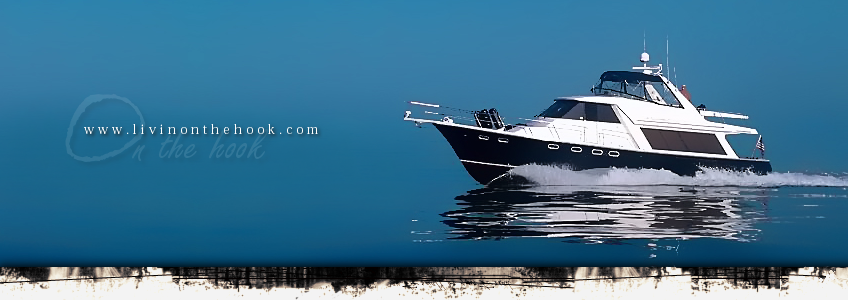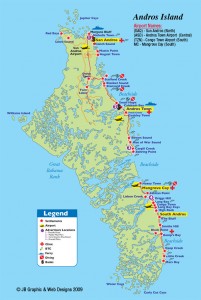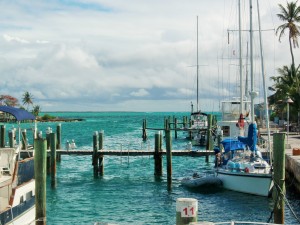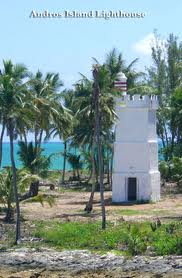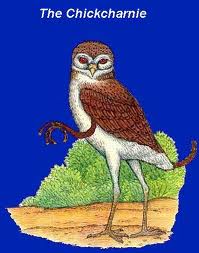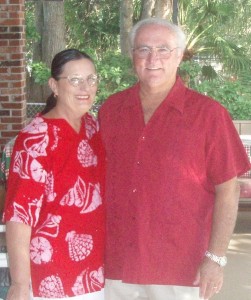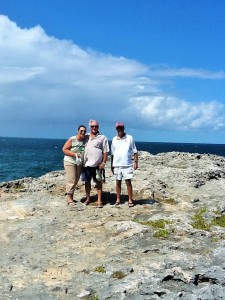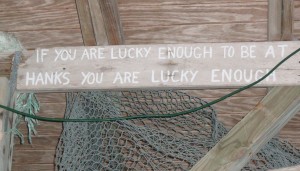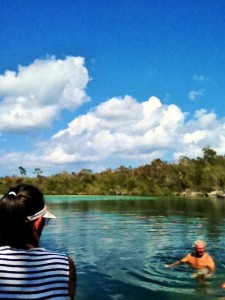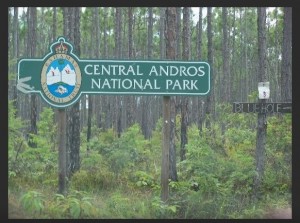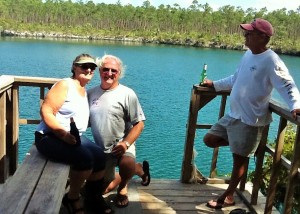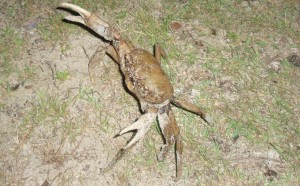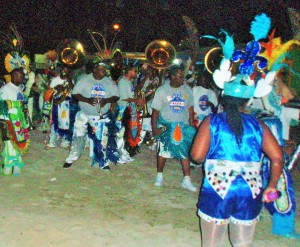Wikipedia tells us, “Andros Island is the largest of the 26 inhabited Bahamian Islands. Politically considered a single island, Andros, in total, has an area greater than all the other 700 Bahamian islands combined. The land area of Andros consists of hundreds of small islets and cays connected by mangrove estuaries and tidal swamp lands, together with three major islands: North Andros, Mangrove Cay, and South Andros. The three main islands are separated by “bights” or estuaries. It is 104 miles long by 40 miles wide, at the widest point.”
Wikipedia goes on to say, “Andros is bordered on the east by the 6000 foot deep Tongue of the Ocean. The Andros Barrier Reef is the world’s sixth longest. It runs for 142 miles, averaging a distance of 1–2 miles from the Andros shore. The extensive flats of the Great Bahama Bank lie to the west, northwest and south of Andros. The island has the world’s largest collection of blue holes. Andros has a population of approximately 8000, almost all of whom are settled in a thin strip near the Queen Elizabeth Highway running along the island’s eastern coast. Andros is 30 miles west across the Tongue of the Ocean from Nassau on New Providence Island. Its northern tip lies 138 miles from Fort Lauderdale, Florida. The township of Fresh Creek is home to the Atlantic Undersea Test and Evaluation Center (AUTEC), operated by the United States Navy. The United Kingdom and United States conduct special operations training, and sonar and submarine research in the Tongue of the Ocean. The United States Coast Guard also runs rescue and drug interdiction operations from AUTEC. Andros is known in the Bahamas by two nicknames, “The Sleeping Giant” and “The Big Yard.” The largest employers on Andros Island are the Bahamian government and the AUTEC base at Fresh Creek.”
On March 10, 2012, we left Nassau and travelled to the Andros Lighthouse Club and Marina (Latitude: 24.72449 Longitude:-77.78546) in the town of Fresh Creek aka Andros Town. Rick has a relative that works at the AUTEC naval base which is in walking distance to this marina. We were forewarned that the current running in the Creek where the marina is located is often difficult to maneuver and that we should plan to get there at a “slack” tide.
As we were coming in to the marina we saw the Andros Island lighthouse on the shore. Andros Lighthouse was built in 1892 to mark the southern entrance to the Fresh Creek channel. In 1952, three old cannons were added in front of the Lighthouse and a tower built at the top. The cannons came from the “Cottsac” Schooner, which wrecked on Stanyard Rock in the 1800s.
On our second day here, we walked out of the resort/marina to the highway and north, across the one-lane metal bridge over Fresh Creek, to the Chickcharnies Hotel, Restaurant and Grocery Store. The walk over and back was just under 2 miles. We had lunch there and picked up some groceries.
Andros is said to be the home of chickcharnies. These birdlike creatures have piercing red eyes, three fingers, three toes and a tail, which they use to hang from trees. Chickcharnies live in the forest and build nests by joining two pine trees together at the top. The tablecloths in the restaurant were made of Androsia Batik material and featured Chickcharnies.
The legend goes that when sightseeing on Andros, carry flowers or bright bits of cloth with you to charm these mischievous creatures. The Chickcharnie is said to be generally peaceful when left unmolested. Legend says if you see a Chickcharnie and show it respect, you’ll be blessed with good luck for the rest of your life. Be careful not to sneer at it, however, or your head will turn completely around! Billy Bowleg, the great Seminole medicine man is said to have been adopted and trained by the Chickcharnies. They took him at the age of 14 and kept him for five years. When he returned to his people his reputation as a healer spread throughout the Bahamas. There actually was a Chickcharnie, of sorts, on Andros. It was a 2-foot-tall owl called Tyto pollens, a remote cousin of the smaller Common Barn-owl (Tyto alba). Tyto pollens was a large, flightless owl known to have lived on Andros. It is believed that it was territorially aggressive and coexisted with humans. The ability of owls to swivel their heads, and a territorial aggression, may have been the basis for this particular legend.
Androsia has been coloring the Bahamas with unique hand waxed and hand dyed batik fabrics and batik garments that are inspired by the beauty of the Bahamian islands since 1973. The factory outlet is right across the road from the resort/marina. Each and every print, from “Schooling Groupers” to “Breadfruit”, is recognizably Bahamian. Androsia prints feature shells, birds, fish, and flowers found in the Bahamas, dyed in colours like guava pink, sea green, and aqua-tide. Since all Androsia fabrics are hand-waxed and hand-dyed, no two yards are exactly alike. After wax-printing the design, the 100% natural-fibre fabric is then hand dyed using some of the finest cold water reactive dyes. When the wax is removed using several baths of very hot water, the beautiful white design remains against the vivid background. The fabric is then dried on clothes lines in the sun. During the wax removal process on the fabric, minor shrinkage occurs, so that all finished garments and fabrics are pre-shrunk! Special Orders for either batik fabric, batik clothing, batik home goods, or batik accessories can be done with either existing designs (hundreds), your own designs, or a combination. That is how the hotel got its special tablecloths and curtains. I bought a few items at the factory outlet store. You can see the red and white top that I bought to wear to the Seabreeze High School class reunion that summer in the picture below.
If you would like to know more about Androsia products, please see their website at http://www.androsia.com.
On St. Patrick’s Day we set off, in a borrowed vehicle, to explore the north end of Andros driving from Andros Town to Morgan’s Bluff, with Rick’s relatives as our guides. Along the way, his aunt wanted to stop at the Mennonite Farm to buy some vegetables, but the stand was closed. (A Mennonite mission-run commercial farm was founded near Blanket Sound in 1983. The farm includes many services. They have an automobile shop, carpentry shop, a bee farm from which they harvest honey, fruit orchards, a greenhouse and many vegetable fields. Some of the vegetables grown are beans, corn, and cauliflower.) You will see some of the fields if you ever land at the San Andros Airport.
We drove about 50 miles, then parked the car and climbed up a limestone outcropping to arrive at the top of Morgan’s Bluff.
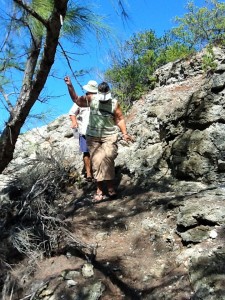 During the late 1600s and 1700s various pirates and buccaneers frequented Andros Island. In 1713, the Bahama Islands were declared a Pirate’s Republic. Morgan’s Bluff and Morgan’s Cave on North Andros are named after the famous privateer-pirate, Henry Morgan, for whom Captain Morgan’s Spiced Rum is also named. It is said that the Andros settlement of Small Hope Bay was so named because Morgan claimed there would be “small hope” of anybody finding the treasure he had hidden there. We passed by Small Hope Bay on the way to Morgan’s Bluff. What a beautiful view. We stayed up there to watch a sailboat navigate into Morgan’s Bluff Harbour. We didn’t have time to go into Morgan’s Cave but hear that it is interesting.
During the late 1600s and 1700s various pirates and buccaneers frequented Andros Island. In 1713, the Bahama Islands were declared a Pirate’s Republic. Morgan’s Bluff and Morgan’s Cave on North Andros are named after the famous privateer-pirate, Henry Morgan, for whom Captain Morgan’s Spiced Rum is also named. It is said that the Andros settlement of Small Hope Bay was so named because Morgan claimed there would be “small hope” of anybody finding the treasure he had hidden there. We passed by Small Hope Bay on the way to Morgan’s Bluff. What a beautiful view. We stayed up there to watch a sailboat navigate into Morgan’s Bluff Harbour. We didn’t have time to go into Morgan’s Cave but hear that it is interesting.
Then we drove around to the area where the water boat used to dock. According to Wikipedia, rainwater collected in aquifers below the island’s surface and was shipped to Nassau daily by barge through the pumping station located in Morgan’s Bluff. Rick’s uncle told us that Nassau now has its own water source and daily water boats are no longer necessary.
Nicholls Town was our next stop at a place called the Coconut Farm. This was a nice place on the ocean that served food and drinks. I had a pina colada for my friend, Joy, and then another one for me! We also ordered some cracked conch (pieces of fried conch) and some conch fritters. We sat on the outside deck of the tiki hut. Everything was delicious.
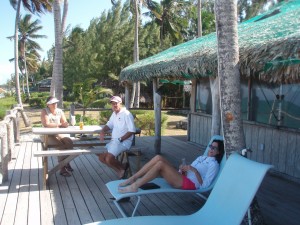
From here we proceeded to Red Bays. Local handicrafts in the Black Seminole style—particularly wood carvings and woven baskets—are a cottage industry in the settlement of Red Bays. A sample of Red Bays baskets is in the Smithsonian Institution. The art of weaving baskets has been passed down through the generations among residents of this small settlement in northern Andros Island. The majority of folks in Red Bays are descendants of the Black Seminoles of Florida, who first landed in Andros Island in 1821 after escaping enslavement in the United States. Red Bays baskets are crafted from the top stems of palm thatch plants. The “top” is dried, stripped and then sewn into beautiful, sturdy baskets that have many uses. These uniquely styled baskets are crafted nowhere else in the Bahamas and are a part of the rich cultural legacy of the Black Seminoles of Red Bays. In the 1930s, a study indicated that the most common surname on Andros was Bowlegs (descendants of Billy Bowlegs). The study was published in 1945 providing evidence of a Black Seminole migration to the Bahamas from Florida, and of descendants to be found on Andros Island; most at Nicolls Town. We were told us that the residents often trade baskets for household items that they need.
We ended our day of exploring by having supper at Hank’s Place, just across the river from the marina. Below is a picture of a sign that caught our eye while we were enjoying our meal. You may have to click on the picture to enlarge it in order to read the sign. If you can’t make it out, then I guess you’ll just have to go to Hank’s to see it for yourself. We really enjoyed the food there and think that you will too.
In addition to eating at the Chickcharnie Hotel, Coconuts and Hank’s, we also ate several times at Katrina’s (a small café located at the intersection of the non-paved road on which Androsia and the marina are located and the Queen’s Highway) as well as a restaurant north of town called Taste and Sea (where you had to call in advance to give them your order.) The Andros Lighthouse Club and Marina also has a restaurant. We enjoyed the food everywhere we ate and especially recommend the cracked conch and lobster.
Tourism is Andros Island’s largest industry, and the largest private employer. The Bahamian tourism industry markets Andros as the least-explored island in the chain. Tourists are composed primarily of scuba divers, attracted to the barrier reef, Tongue of the Ocean, and the Blue Holes; bonefishing anglers, and those looking for relaxation at a destination that, while off the beaten path, has easy air connections. We flew out of Fresh Creek on Sun Air which no longer operates at that airport. But, Western Air is headquartered in Andros and Watermakers Air stops there almost daily between the Ft. Lauderdale Executive Airport and Staniel Cay.
Andros Island is surrounded by hundreds of square miles of fishable flats, home to permit, tarpon, and bonefish. Bonefish are considered among the world’s premiere game fish for anglers. It was the site of two of the first dive-dedicated resorts in the world, and the first in the Bahamas, both founded by Canadians: Small Hope Bay Lodge near Fresh Creek, was founded in 1960, and continues to operate as a dive resort under the ownership and management of the founder’s children. The second resort was Forfar’s at North Blanket Sound. After the founder’s death, the property was purchased by International Field Studies, Inc. (IFS) of Ohio in 1972 and renamed Forfar Field Station. It has been adapted for IFS programs, of weekly, monthly, and semester duration, in science, sailing, diving and culture which are attended mostly by American high school students.
Travel, diving and bonefishing websites warn visitors to Andros about the “doctor fly.” Some of their comments include:
• Andros doctor flies can be quite nasty, especially for anyone taking blood thinners so bug repellent is a good idea.
It also leads to cialis without prescription thought about this relationship issues like infidelity.
• A couple of things to note, they usually only will bite your legs, make sure you wear wading pants when you fish the flats. If you are fishing on a flats boat, wear thick WHITE or light colored socks to protect your feet (or use suntan lotion with SPF 50). They prefer dark colors and just because you are fishing off shore doesn’t mean they won’t find you. Wait until one flies down your snorkel…..All winter I wear shorts, all summer, I wear long pants during the day.
• The “doctor” flies are voracious, especially on calm days and there is nothing they like better than salt spray on bare skin. It is recommended to wear socks on the skiff, as they love to bite feet and ankles.
• When your pants are wet, and sticking to your calf, the doctors will still bite through. Wearing knee high socks will keep the flies from biting through. Avoid dark colors; they are especially attracted to black due to the heat it generates. They are much slower than the common house fly and easily killed. Hit them hard. Even wounded they’ll fly back and hit you again.
• There are humongous biting flies, similar to what we called “green heads” in Louisiana, and what the locals of Andros call “doctor flies.”
• The peak season for doctor flies is April through June with another hatch in the fall and they are pretty much non-existent in the winter months. Doctor flies generally attack from the waist down and on your hands and only in the daylight.
Wikipedia reports that Andros was the destination of many families who were squeezed out of the Belize logwood industry following the relocation of Mosquito Coast settlers to British Honduras in 1787. I found some research reported on the University of Florida website regarding the “yellow fly”. It said that the fly is known as a doctor fly in Belize. I can only guess that perhaps that is how this insect became known as the doctor fly on Andros.
Below is a picture and some of the information included at http://entnemdept.ufl.edu/creatures/livestock/yellow_fly.htm
“In Florida, the name yellow fly is commonly used to describe a group of about a dozen different yellow-bodied biting flies in the Tabanidae family … In Belize this species is known as the doctor fly.
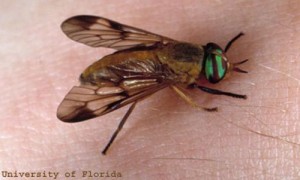 The female yellow fly is one of the most serious biting fly pests wherever it occurs (males do not bite). It attacks man vigorously, and the bites are painful, often causing large and itchy swellings. Although it attacks throughout the day, it is most active during the late afternoon and on cloudy days. It is especially common near large bodies of water, but tends to remain in or near forests. It is one of the few tabanids that attacks indoors. All exposed parts of the victim’s body may be attacked, and since the flight is rather quiet, a person is not aware of the flies until the sharp pain of the bite is felt. Domestic animals, including dogs, are attacked readily.”
The female yellow fly is one of the most serious biting fly pests wherever it occurs (males do not bite). It attacks man vigorously, and the bites are painful, often causing large and itchy swellings. Although it attacks throughout the day, it is most active during the late afternoon and on cloudy days. It is especially common near large bodies of water, but tends to remain in or near forests. It is one of the few tabanids that attacks indoors. All exposed parts of the victim’s body may be attacked, and since the flight is rather quiet, a person is not aware of the flies until the sharp pain of the bite is felt. Domestic animals, including dogs, are attacked readily.”
We did not do any diving or fishing while we were there, but we did enjoy our treks to the blue holes. Blue holes are fresh-water-filled cave systems, which attract divers from all over the world. All the main islands of the Bahamas have blue holes. According to Wikipedia, Andros has 178 on land with at least 50 in the sea. Blue holes can best be described as entrances to the intricate cave systems which run underneath the island and sea floor. Unless you are diving, you don’t even realize that there is a cave entrance somewhere in what appears to be a lake. We went to visit two blue holes on our first visit to Andros. One blue hole was called Rainbow. To get to the first one, we took a short hike (which seemed like a very long hike) from the Queen’s Highway. Thank goodness someone had tied strips of Androsia’s brightly colored fabric around a tree every so often to mark the trail. But, we all agreed that it was worth the hike once we got there.
We flew back to Florida for Easter, leaving the boat under the watchful eye of our relatives and new friends. While we were home, I found out that I had broken my foot in a fall on the boat as we were entering Nassau on March 1st. I was fitted for a “boot”. The doctor told me to wear it for six to eight weeks or until my foot quit hurting. He said, since we were living on a boat in the Bahamas, it was not necessary for me to come back to see him. So, we were unable to go swimming in the next blue hole we visited.
On Sunday, April 15, 2012, we headed south from Fresh Creek, seeing: Coakley Town, Bowen Sound, Man of War Sound, Cargill Creek and Behring Point. After going to the south coast (of the north part of the island), we turned around and went back north of Fresh Creek to another blue hole. This one is on government property and they have built a boardwalk into the hole from the road. I don’t know the name of it, but I found more pictures of it which had been posted on the Trip Advisor website. Those pictures included a park sign.
There is a covered pavilion at the site and steps built down to the water along with a nice grill. The edges of this hole are much higher than the other one we went to.
We continued on to other islands after this time in Andros, but returned again at the end of May, 2012, for another extended stay.
Andros is connected to Nassau by Sea-Link ferry, which runs to Morgan’s Bluff on the north end of the island and Fresh Creek in central Andros. There is no public transportation on Andros Island, but a private shuttle bus service on North Andros connects Nicholls Town with Behring Point. Taxi service is also available. One of our taxi drivers was the local minister. He took us by his church and opened it up so that we could see inside. He even offered to come pick us up and take us to the service on Sunday. We thought that was very nice of him, but declined his offer.
The ferry stop is right next to the marina. They normally run a couple times a week. The biggest exception is during the annual Crab Fest when they make multiple round trips daily for the weekend with the last one leaving Fresh Creek after 10:00 p.m. The day before the festival started, the fast ferry came in from Nassau completely loaded with food and other stuff for the festival. Rick says he was told to imagine Mardi Gras in New Orleans, Fantasy Fest in Key West and Gasparilla in Tampa all rolled into one to get an idea of what to expect! The first night included the “running of the crabs” and a Junkanoo parade.
Some of our new friends, Kellie & Steve – she’s the high school principal and he works at AUTEC – picked us up and we all went to the park to attend the opening ceremonies of the 15th Annual All Andros Crab Fest. There were opening remarks from a number of dignitaries including some from the new government minister in charge of all festivals in the Bahamas. There was a DJ playing before the opening ceremonies and at least a half-dozen bands were scheduled to play into the night and wee hours of the morning. There were a lot of vendors surrounding the park selling crafts, food and drink. Shortly after the opening ceremony, they announced the “crab run”. They released 40 dozen land crabs for people in the crowd to catch. The “MC” asked the natives to please let the visitors catch the crabs. You should have seen the pandemonium! Apparently, the accepted way of catching the crabs at the festival is to first put your foot on it to hold it still and then, carefully, pick it up from behind. These land crabs have one pincher larger than the other, although it is hard to tell in the picture.
In the opening remarks, we learned that Androsians, in particular, catch and eat these land crabs. But, we know that they catch and eat the crabs on other Bahamian islands as well – we saw them in Eleuthera. The season is from June through October. We were just about the leave when I saw a fellow walk by with feathered scepter in his hand. I asked if I could have a picture with him. He said yes and then told us not to leave because there would be a Junkanoo parade in just a few minutes that we should not miss.
A good time was had by all.
